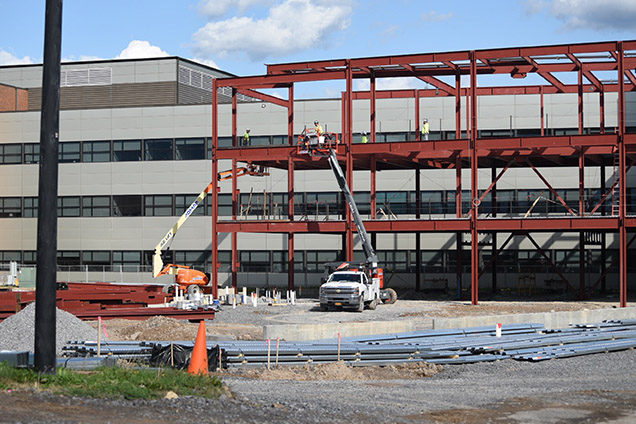The construction of the new building near Golisano Hall is not just an expansion of the Computing Security department, but also an initiative to grow RIT's status in cybersecurity education and research.
The graduate program director within the Golisano College of Computing and Information Sciences (GCCIS) and professor in the department of Computing Security, Dr. Sumita Mishra, sees the building — the Global Cybersecurity Institute — with a vision that is much broader than the Computing Security department.
“[The new center is a] focused area where all kinds of things in cybersecurity coexist, and that’s the exciting part. The depth that is required is unique. I don’t see many places where you’d have a dedicated space like this for hosting all kinds of things," she said. "In the long run, this gives us a visibility for our programs, for our cybersecurity education as well as our research.”
According to Dr. Matthew Wright, director of the Center for Cybersecurity Research, the new institute will include faculty from the Computer Science, Software Engineering, Computer Engineering and Computing Security departments to work on interdisciplinary cybersecurity research. Having all of these resources and faculty in one area will improve RIT's renown in this field.
"I don’t see many places where you’d have a dedicated space like this for hosting all kinds of things."
Benefits for Students
The facility will feature a variety of areas for people to work and hang out; this includes amenities such as student lounges, research labs, instructional labs and spaces for faculty and Ph.D. students. The most anticipated of these state-of-the-art lab spaces are the new Cyber Range and the air-gapped lab.
The Cyber Range will be a cybersecurity training facility for students, faculty and industry professionals. It will be modeled after the IBM X-Force Command Cyber Range — a lab created by IBM to model and simulate real-world cybersecurity threats for training and practice.
According to Wright, this will allow training through real, hands-on cyber threats, such as ransomware and distributed denial of service (DDoS) attacks. The former, ransomware, entails a virus encrypting your hard drive and forcing you to pay a fee to unlock it and regain access. The latter, DDoS, is an attack in which many computers bombard a target with repeated requests, with the goal of causing this target to crash.
Meanwhile, the air-gapped lab will be a computer lab completely disconnected from the outside world. This will allow students and faculty to study and analyze malware without the danger of wreaking havoc on RIT’s network.
Wright also stated that other departments in GCCIS are beginning to add computing security classes to their curriculum. The increased physical space will help the department to accommodate more of these students from other majors.
The new complex is expected to be completed as early as summer 2020, and the department is hoping to settle into their new home before the next Fall semester. Until construction is completed, the exits on the west side of Golisano Hall will be inaccessible to students, along with several sidewalks in the area.
Impact on Research
In addition to the new perks for cybersecurity students, the new building also provides the department a platform for their long-term growth. Wright said that the building will also allow the Computing Security department to increase their number of undergraduate students from around 400 to 500. They will also be able to double the number of master's degree students to 100 and double their number of Ph.D. students to about 40.
"This growth would have been impossible without the new building," Wright said.

According to Wright, the Ph.D. students have simply run out of space. Despite the Computing Security department's expansion within GCCIS over the years, the extra space has always filled up as soon as it became available. The new building will allow these students to have more space to work, and they will be able to accommodate a larger group of students. This will help the department increase the amount of research being done.
The new building will also be full of resources that will foster research in cutting edge technology.
"These labs will be equipped with the latest security equipment. In terms of research labs, we will have things like IoT (internet of things) devices, anything that is current," Mishra said. "It will include technologies that exist today, as well as the infrastructure to carry out cutting-edge research."
"It will include technologies that exist today as well as the infrastructure to carry out cutting-edge research."
Global Outreach
Mishra explained that one of the most important aspects of the Global Cybersecurity Institute is the emphasis on global outreach, which increases the visibility of RIT's programs internationally.
Wright is confident the new institute will help RIT “develop more partnerships with organizations and universities in other countries ... with the purpose of doing joint research, ... dual degree programs and student and faculty exchanges.”
Both Mishra and Wright emphasized that creating more connections and developing partnerships with other universities will improve the overall quality of RIT's long-term cybersecurity research and education.
Wright said, “If everyone thinks the same way, you don’t innovate very much. So when you bring in diverse viewpoints, it helps to accelerate and improve the quality of innovation.”
This will also have tangible benefits for students interested in cybersecurity as the institute works toward advancing its cybersecurity program further.
RIT’s campus in Dubai is also growing its cybersecurity program as part of the university's global ambitions in the field. Wright elaborated that they are in the process of adding a Computing Security master’s degree program to complement their existing undergraduate program.
The new Global Cybersecurity Institute marks a new direction in the university’s desire to compete in the global computing security field.
The resources, facilities, faculty and extra space of the new institute will allow the Computing Security department to keep up with the growing demand for the major and to grow in unprecedented ways by taking in more students and fostering more connections with the global cybersecurity community, according to Mishra.
In Mishra's opinion, "the exciting part of this is that it gives a presence for not just our department, but cybersecurity professionals in entirety."










